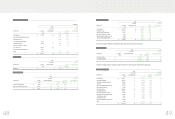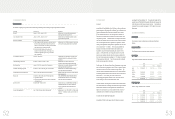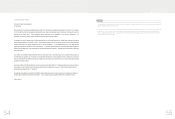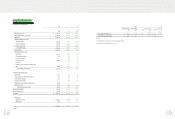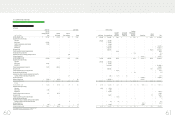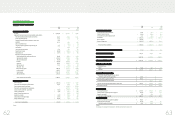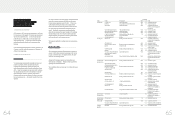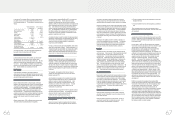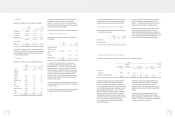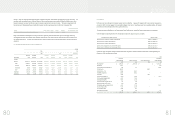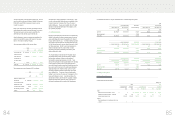HTC 2009 Annual Report Download - page 88
Download and view the complete annual report
Please find page 88 of the 2009 HTC annual report below. You can navigate through the pages in the report by either clicking on the pages listed below, or by using the keyword search tool below to find specific information within the annual report.
loss carryforward and unused tax credits. Valuation allowances are
provided to the extent, if any, that it is more likely than not that
deferred income tax assets will not be realized. A deferred tax
asset or liability is classified as current or noncurrent in accordance
with the classification of its related asset or liability. However, if a
deferred income tax asset or liability does not relate to an asset or
liability in the financial statements, then it is classified as either
current or noncurrent based on the expected length of time before it
is realized or settled.
Tax credits for purchases of machinery, equipment and technology,
research and development expenditures, and personnel training
expenditures are recognized using the flow-through method.
Adjustments of prior years’ tax liabilities are added to or deducted
from the current year’s tax provision
According to the Income Tax Law, an additional tax at 10% of
unappropriated earnings is provided for as income tax in the year the
stockholders approve to retain the earnings.
All subsidiaries file income tax returns based on the regulations of
their respective local governments. In addition, there is no material
difference in the accounting principles on income taxes between the
parent company and those of its subsidiaries.
Treasury Stock
The Company adopted the Statement of Financial Accounting
Standards No. 30 - “Accounting for Treasury Stocks,” which requires
the treasury stock held by the Company to be accounted for by the
cost method. The cost of treasury stock is shown as a deduction to
arrive at stockholders’ equity, while gain or loss from selling treasury
stock is treated as an adjustment to capital surplus.
When treasury stocks are sold and the selling price is above the book
value, the difference should be credited to the capital surplus -
treasury stock transactions. If the selling price is below the book
value, the difference should first be offset against capital surplus
from the same class of treasury stock transactions, and any
remainder should be debited to retained earnings. The carrying
value of treasury stocks should be calculated using the
weighted-average method.
When the Company's treasury stock is retired, the treasury stock
account should be credited, and the capital surplus - premium on
stock account and capital stock account should be debited
proportionately according to the share ratio. The difference should
be credited to capital surplus or debited to capital surplus and/or
retained earnings.
Foreign Currencies
The financial statements of foreign operations are translated into
New Taiwan dollars at the following exchange rates:
a. Assets and liabilities - at exchange rates prevailing on the balance
sheet date;
b.Stockholders’ equity - at historical exchange rates;
c. Dividends - at the exchange rate prevailing on the dividend
declaration date; and
d. Income and expenses - at average exchange rates for the year.
Exchange differences arising from the translation of the financial
statements of foreign operations are recognized as a separate
component of stockholders’ equity. Such exchange differences are
recognized as gain or loss in the year in which the foreign operations
are disposed of.
Nonderivative foreign-currency transactions are recorded in New
Taiwan dollars at the rates of exchange in effect when the
transactions occur. Exchange differences arising from the
settlement of foreign-currency assets and liabilities are recognized as
gain or loss.
At the balance sheet date, foreign-currency monetary assets and
liabilities are revalued using prevailing exchange rates and the
exchange differences are recognized in profit or loss.
At the balance sheet date, foreign-currency nonmonetary assets (such
as equity instruments) and liabilities that are measured at fair value
are revalued using prevailing exchange rates, with the exchange
differences treated as follows:
a. Recognized in stockholders’ equity if the changes in fair value are
recognized in stockholders’ equity; and
b. Recognized in profit and loss if the changes in fair value is
recognized in profit or loss.
Foreign-currency nonmonetary assets and liabilities that are carried at
cost continue to be stated at exchange rates at the trade dates.
If the functional currency of an equity-method investee is a foreign
currency, translation adjustments will result from the translation of the
investee’s financial statements into the reporting currency of the
Company. These adjustments are accumulated and reported as a
separate component of stockholders’ equity.
Reclassifications
Certain 2008 accounts have been reclassified to be consistent with
the presentation of the financial statements as of and for the year
ended December 31, 2009.
3. TRANSLATION INTO U.S. DOLLARS
The financial statements are stated in New Taiwan dollars. The
translation of the 2009 New Taiwan dollar amounts into U.S. dollar
amounts are included solely for the convenience of readers, using the
noon buying rate of NT$31.99 to US$1.00 quoted by the Bank of
Taiwan on December 31, 2009. The convenience translation should
not be construed as representations that the New Taiwan dollar
amounts have been, could have been, or could in the future be,
converted into U.S. dollars at this or any other exchange rate.
)LQDQFLDO,QIRUPDWLRQ
Properties
Properties are stated at cost less accumulated depreciation.
Borrowing costs directly attributable to the acquisition or
construction of properties are capitalized as part of the cost of those
assets. Major additions and improvements to properties are
capitalized, while costs of repairs and maintenance are expensed
currently.
Assets held under capital leases are initially recognized as assets of
the Company at the lower of their fair value at the inception of the
lease or the present value of the minimum lease payments; the
corresponding liability is included in the balance sheet as obligations
under capital leases. The interest included in lease payments is
expensed when paid.
Depreciation is calculated on a straight-line basis over the estimated
service lives of the assets plus one additional year for salvage value:
buildings (including auxiliary equipment) - 3 to 50 years; machinery
and equipment - 3 to 5 years; office equipment - 3 to 5 years;
transportation equipment - 5 years; and leasehold improvements - 3
years.
Properties still in use beyond their original estimated useful lives are
further depreciated over their newly estimated useful lives.
The related cost (including revaluation increment) and accumulated
depreciation are derecognized from the balance sheet upon its
disposal. Any gain or loss on disposal of the asset is included in
nonoperating gains or losses in the year of disposal.
If the properties are leased to others, the related costs and
accumulated depreciation would be transferred from properties to
other assets - assets leased to others.
Intangible Assets
Intangible assets acquired are initially recorded at cost and are
amortized on a straight-line basis over their estimated useful lives.
Effective January 1, 2006, based on a newly released SFAS No. 37,
goodwill arising on acquisitions of other companies is no longer
amortized and instead is tested for impairment annually. If
circumstances show that the fair value of goodwill has become lower
than its carrying amount, an impairment loss is recognized. A
reversal of this impairment loss is not allowed.
Deferred Charges
Deferred charges are telephone installation charges, computer
software costs and deferred license fees. Installation charges and
computer software are amortized on a straight-line basis over 3
years, and deferred license fees, over 10 years.
Asset Impairment
If the recoverable amount of an asset is estimated to be less than its
carrying amount, the carrying amount of the asset is reduced to its
recoverable amount. An impairment loss is charged to
earnings unless the asset is carried at a revalued amount, in which
case the impairment loss is treated as a deduction to the unrealized
revaluation increment.
If an impairment loss subsequently reverses, the carrying amount of
the asset is increased accordingly, but the increased carrying amount
may not exceed the carrying amount that would have been
determined had no impairment loss been recognized for the asset in
prior years. A reversal of an impairment loss is recognized in
earnings, unless the asset is carried at a revalued amount, in which
case the reversal of the impairment loss is treated as an increase in
the unrealized revaluation increment. A reversal of an impairment
loss on goodwill is disallowed.
For long term equity investments for which the Company has
significant influence but with no control, the carrying amount
(including goodwill) of each investment is compared with its own
recoverable amount for the purpose of impairment testing.
Accrued Marketing Expenses
The Company accrues marketing expenses on the basis of
agreements, management’s judgment, and any known factors that
would significantly affect the accruals. In addition, depending on the
nature of relevant events, the accrued marketing expenses are
accounted for as an increase in marketing expenses or as a decrease
in revenues.
Reserve for Warranty Expenses
The Company provides warranty service for one to two years
depending on the contract with customers. The warranty liability is
estimated on the basis of management’s evaluation of the products
under warranty, past warranty experience, and pertinent factors.
Product-related Costs
The cost of revenues consists of costs of goods sold, write-downs of
inventories and the reversal of write-downs. The provisions for
product warranty are estimated and recorded under cost of revenues
when sales are recognized.
Pension Plan
Pension cost under a defined benefit plan is determined by actuarial
valuations. Contributions made under a defined contribution plan are
recognized as pension cost during the year in which employees
render services.
Curtailment or settlement gains or losses on the defined benefit plan
are recognized as part of the net pension cost for the year.
Income Tax
The Company applies intra-year and inter-year allocations for its
income tax, whereby (1) a portion of income tax expense is allocated
to the cumulative effect of changes in accounting principles; and (2)
deferred income tax assets and liabilities are recognized for the tax
effects of temporary differences, unused
)LQDQFLDO,QIRUPDWLRQ


